In case you didn’t know, David Thompson has been putting out some really good and entertaining wargames over the past couple of years. One of his finest has been the 2019 hit Undaunted: Normandy which is a card based small squad tactical game that uses deckbuilidng and a modular board with scenarios to tell the story of the 30th Infantry Division as they marched across Europe following their landing on D-Day during World War II. Due to that game’s success a new expansion has been designed and released and is simply fantastic. Undaunted: North Africa adds in several new elements, including new abilities, new cards, new terrain and scenarios but most importantly vehicles.
One thing I want to get out of the way early in this series is that this game is not simply the same product with a new setting, new package and more stuff. This game feels very different and has a smaller scale feel from its predecessor Undaunted: Normandy. It feels more intimate and the squad level concept has been shrunk to feel more like a small team of commandos, with the addition of some very cool and interesting vehicles, trying to execute their missions.
In this series of Action Points we will first take take a look at the deck building aspect, including the makeup of the deck and how you “build” it, dive into a look at the new units in the game and their special abilities including vehicles, new weapon types, new actions and new terrain, take a look at the major differences between North Africa and Normandy and what has changed and finally cover some basic concepts of strategy to keep in mind about how units are best used and how to exploit their special abilities.

The Deck Makeup
Your deck consists of various types of cards that each play a role in the game and represent your soldiers, leaders and the chaos and confusion of the battlefield. Each game, players will start with a certain number of cards already in their decks with other cards that are available in what is called a personal Supply which can be added to the deck as the game progresses. There are three types of specific cards that make up the deck including Combat Cards, Command Cards and Fog of War Cards. There are new Vehicle Cards in this game but they don’t go into your deck and start on the board based on the scenario that is being played. These cards are also larger than the cards that go into the deck and are only used to track damage and to identify the actions that each of the different vehicles can take. Let’s take a quick look at each of these types.
Combat Cards
Combat Cards represent each of the individual soldiers in your platoon and each of these cards has their own Combat Counter used to identify their location on the board and their current status, such as suppressed.
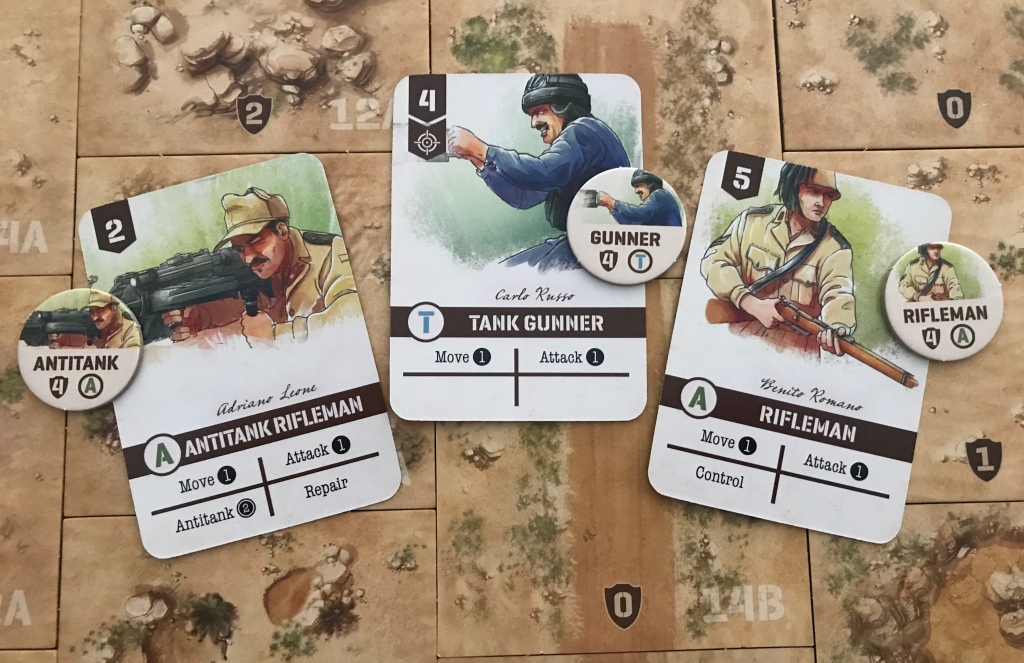
In the picture above you will see several numbers and letters on the card as well as the name of the soldier and it’s type (Antitank Rifleman, Tank Gunner, Rifleman, etc.). The number in the upper left corner is the Initiative value used to bid for Initiative each round while the numbers after the various actions inside a black circle denote how many spaces the unit can Move or the number of dice the unit rolls in an Attack. The capitalized letter on the left side represents the unit’s Squad Designation, which was much more important in Normandy as there were multiple squads that were included in each scenario. Finally, any special abilities that the unit has will be listed on the bottom of the card such as Control, Repair, Antitank, etc., which are used in specific situations such as taking Control of a tile on the board to gain Objective Points, Repairing damage taken by a Tank, etc.
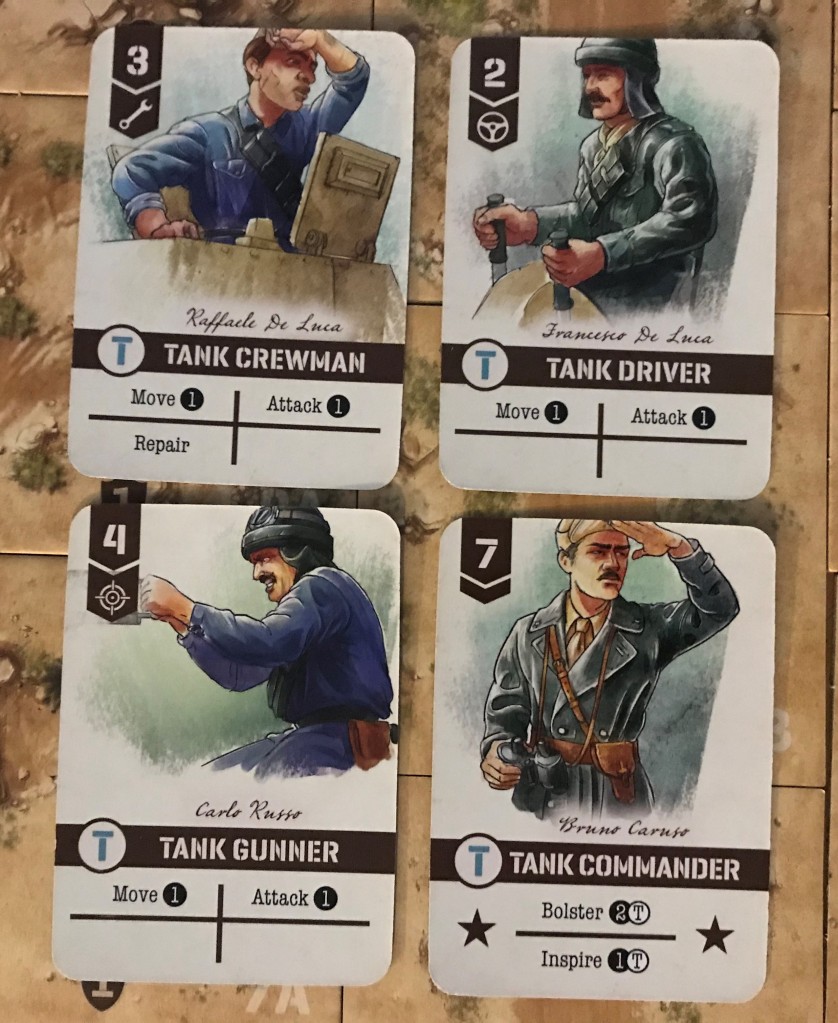
You will also notice a unique symbol located just under the Initiative value in the top left. This symbol is called a Specialism and refers to the skills that the soldier possesses that enable them to operate certain vehicles. Only the Italian Tank Driver, Tank Crewman and Tank Gunner have these Specialisms. You will also notice that I included a picture of a Command Card above of the Tank Commander who has a Command symbol under the Initiative value.
One other element that is included on the cards that is pretty cool, but doesn’t have any impact on gameplay itself, is the name of the soldier. These were added for historical effect as David and Trevor did research into the names of the soldiers that served in these units. The art for the game is also fantastic and is done by Roland MacDonald and really sets the tone for the game allowing me to get involved in each of the units in my platoon and literally see the theme.
Command Cards
Command Cards represent the leaders of your platoon and include both commissioned and non-commissioned officers. Unlike the Combat Cards, these leaders do not have an individual counter used to represent them on the battlefield.
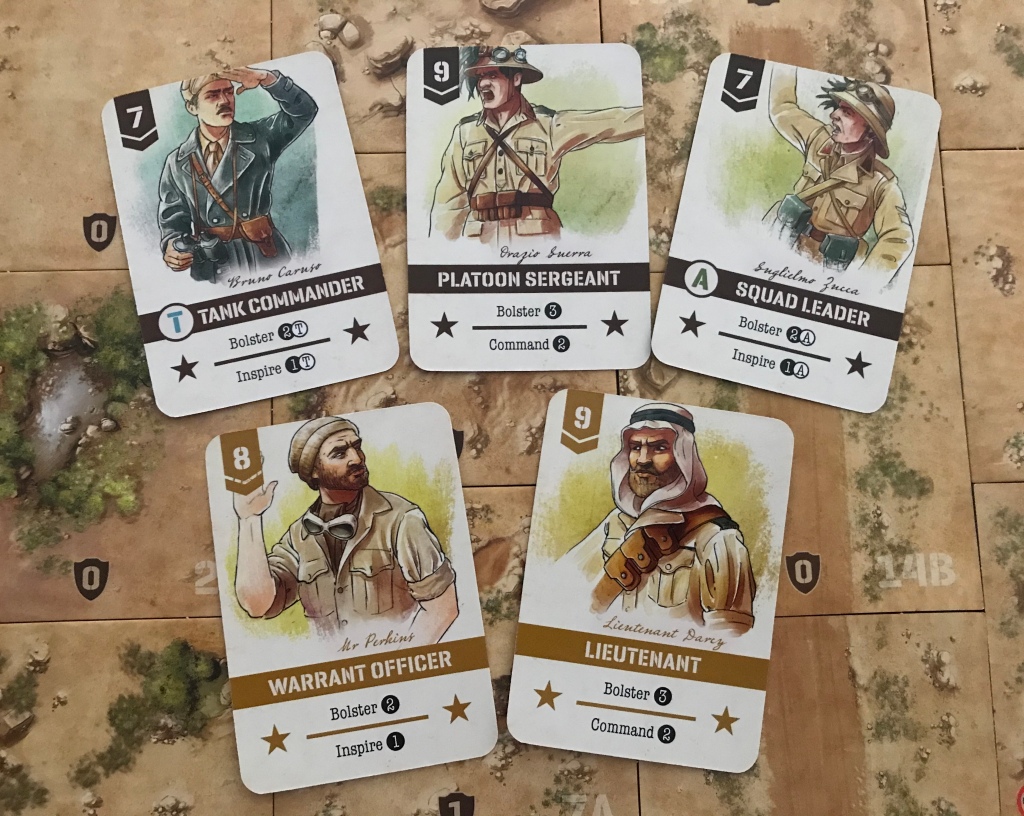
The Command Cards are laid out the same as a Combat Card but with a few extra elements. The stars around the actions on the bottom of the card denote that this is a Command Card. The Command Card’s actions effect cards in the player’s decks and have special actions that allow you to draw extra cards or pick up cards that have already been played. You will notice that the Squad Leader and Tank Commander is a bit different as it identifies with an A or a T next to the Bolster Action. This means that this card is limited in only being able to add cards of the designated squad into your deck.
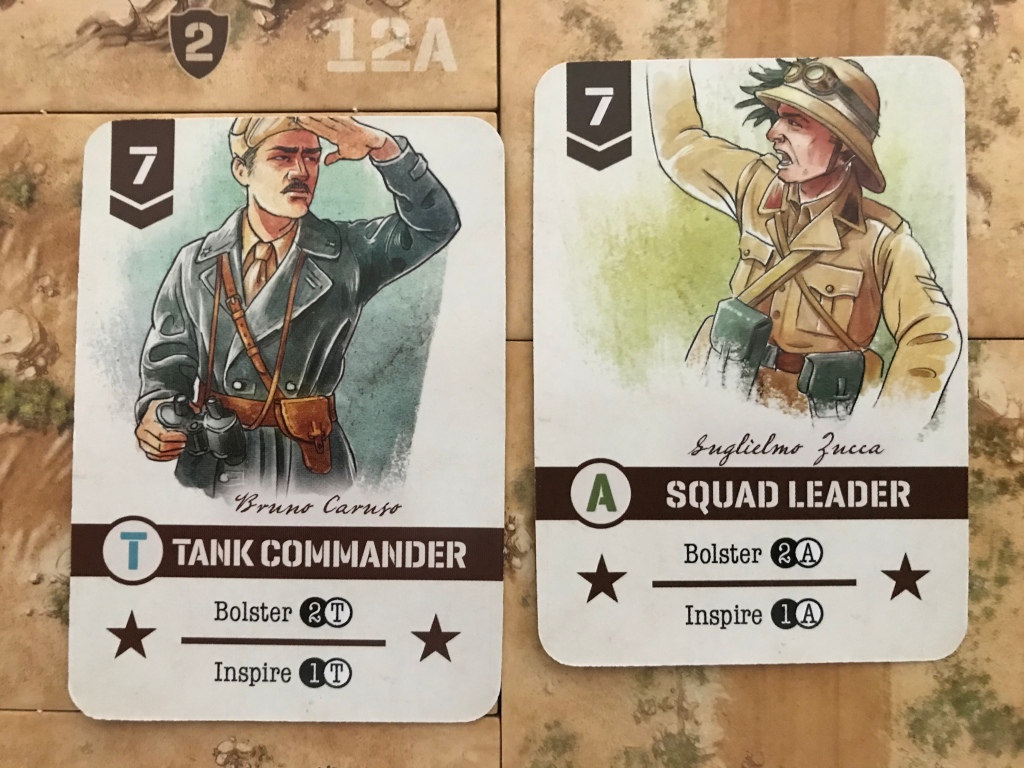
Fog of War Cards
Fog of War Cards are representative of the difficulties of command and control during the chaos of a battle. They cannot be used for any action during battle other than to bid for Initiative and simply take up space in your deck. When you draw a Fog of War Card you will simply have one less action that round.
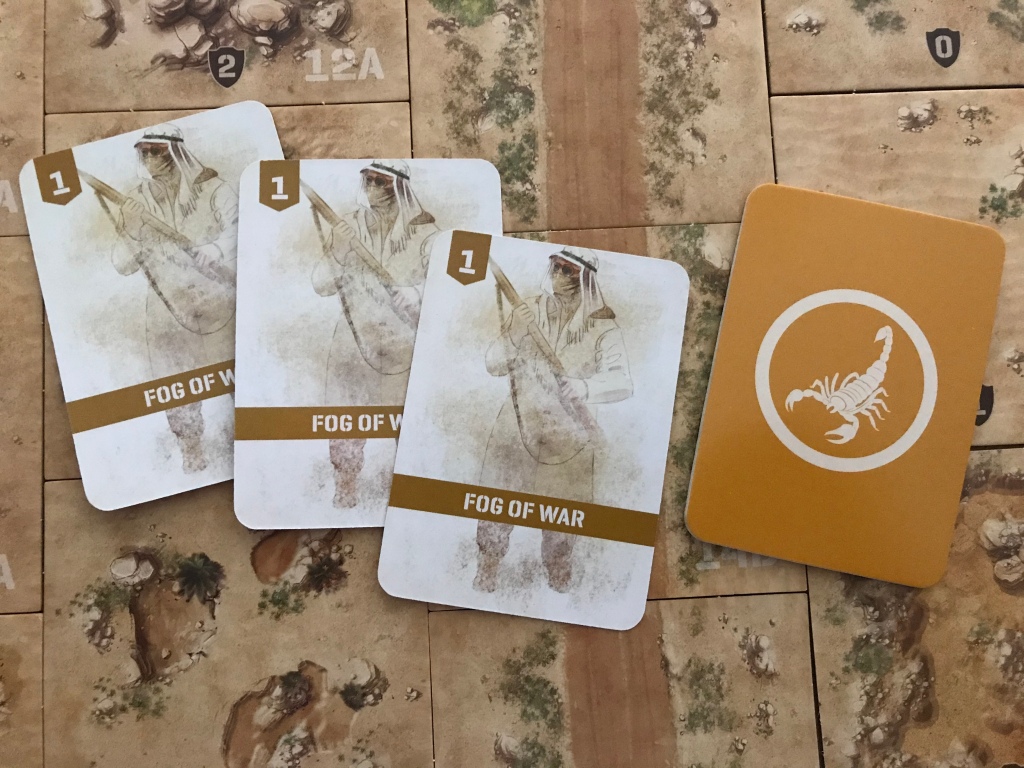
The only way to get rid of a Fog of War Card is to use the special ability of a Scout, Staff Sergeant or Recon Aircraft to Recon that card. This means you can remove the Fog of War Card from your hand (it cannot be from your discard pile) and get it out of your deck and also remove it from the game. But beware as your opponent can use their Scouts other special ability called Conceal to put another Fog of War Card into your discard pile which will be added to your deck upon reshuffling.
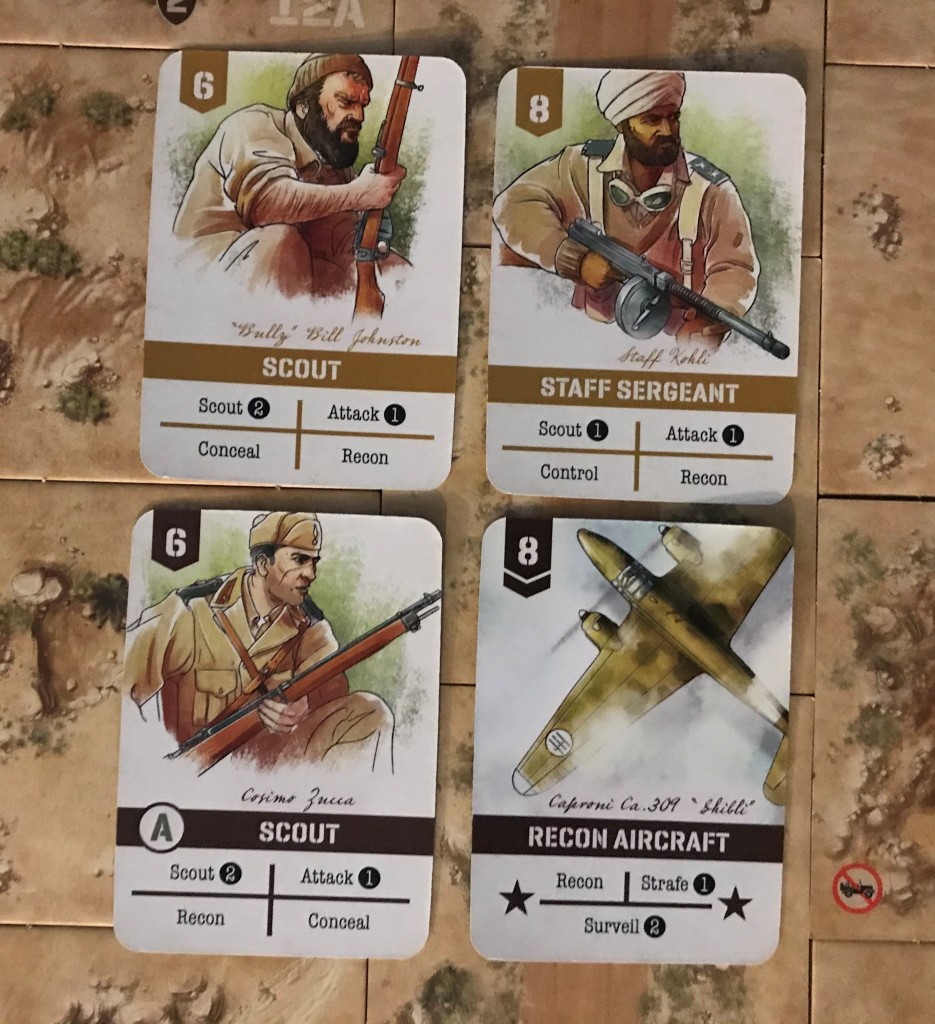
How You “Build” Your Deck
First off, your starting deck is different for each scenario. You will find the makeup of the deck in the Starting Cards section pictured below. To “build” your starting deck take one copy of each card shown with the D symbol surrounded by a black circle. You will shuffle these cards into a facedown deck and this deck will be available at the start.
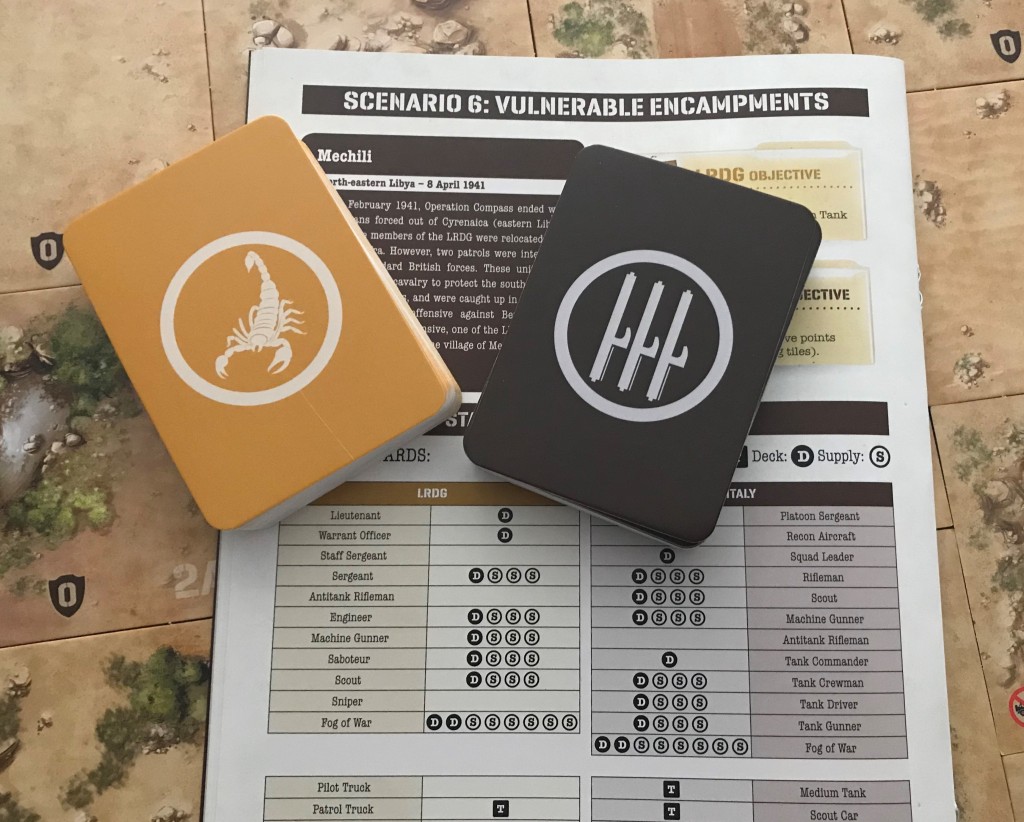
To assemble your Supply, or the cards that are available to add to your deck, take one copy of each card per S in a white circle symbol shown on the table. Place those cards into a face up Supply laid out next to your play area in easy reach. All remaining cards not listed on the table will be returned to the box for use in another scenario.
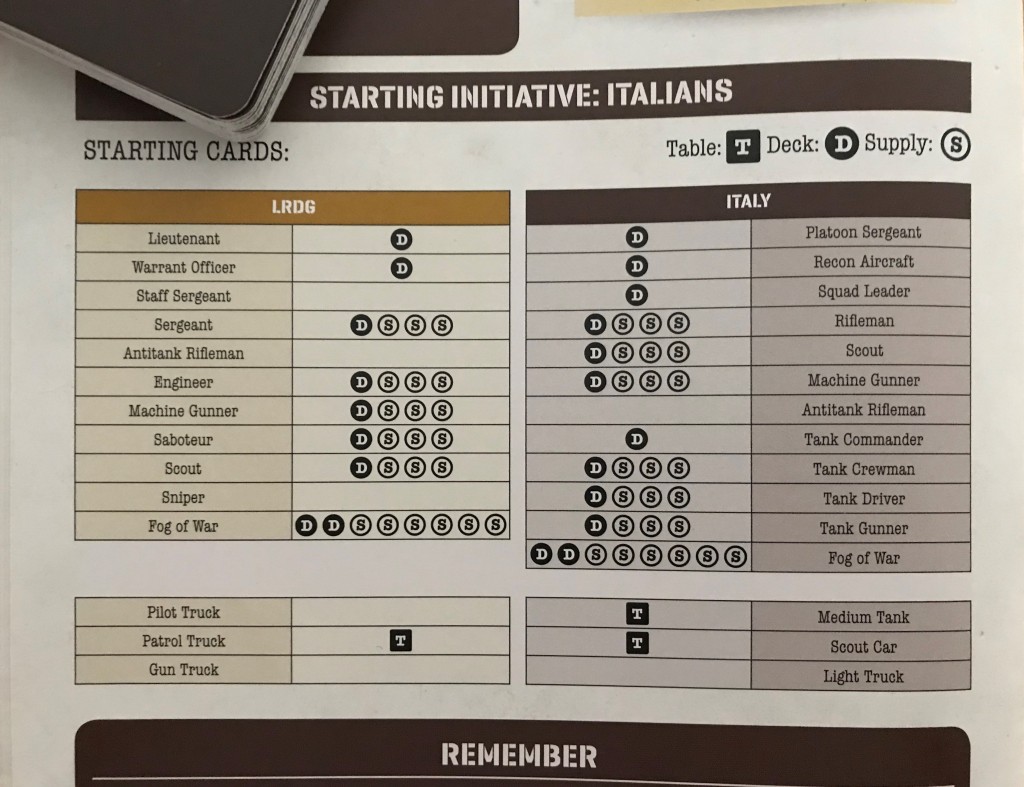
Now let’s take a quick look at the deck building aspect. Deck building really is at the heart of the design and is the engine that keeps the game moving. Over the course of the game, players will use their platoon’s Command Cards, including the Tank Commander, Platoon Sergeant and Squad Leader for the Italian player and Warrant Officer and Lieutenant for the Long Range Desert Group, to Bolster (a fancy term for adding cards from the Supply to your Deck) the units of the platoon that you want to focus on.
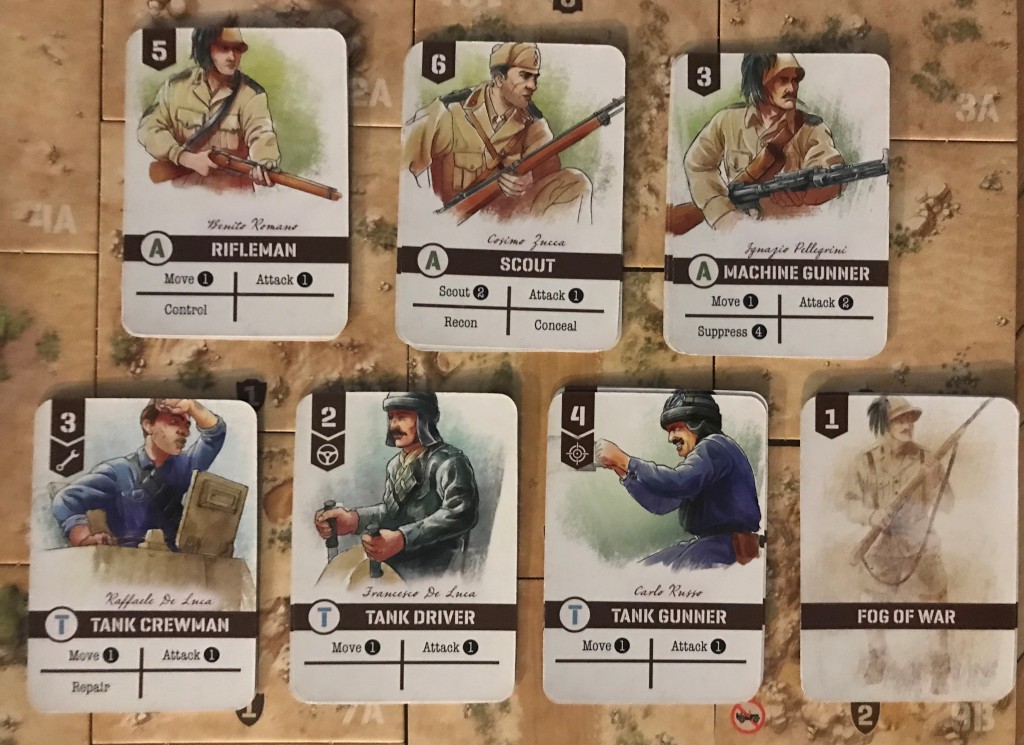
The more cards you add of a particular unit, the more effective and resilient it will be, meaning that the card will come up in your draws more often and allow you to use those units more. If you want to concentrate fire from a Machine Gunner, then Bolster all that Machine Gunners cards into your deck so you’ll draw it more frequently. If you want to make a move for an Objective near your Rifleman, then Bolster copies of that Rifleman into your deck.
In addition, when a counter on the board representing that unit is successfully attacked by your enemy, you’ll remove the matching card from your deck but will have more copies to draw. Once all cards of that type have been successfully attacked the counter will be removed from the board.
The deck building element of this design is very well done and actually makes perfect thematic sense against the backdrop of a LRDG or Italian Rifle platoon during World War II. A leader was asked to assemble the appropriate men and resources, deploy them properly on the battlefield, order them to move tactically to approach and capture objectives and call in reinforcements as his men were attacked, injured and killed. This sounds a lot like the deck building mechanic and I think it was a perfect choice for this light, fast playing and clever game.
We posted an interview with David Thompson one of the designers for the game and it gives good insight into the design. You can read that interview here: https://theplayersaid.com/2020/07/06/interview-with-david-thompson-codesigner-of-undaunted-north-africa-from-osprey-games/
In Action Point 2, we will take a look at the new units in the game and their special abilities including vehicles, new weapon types, new actions and new terrain.
-Grant
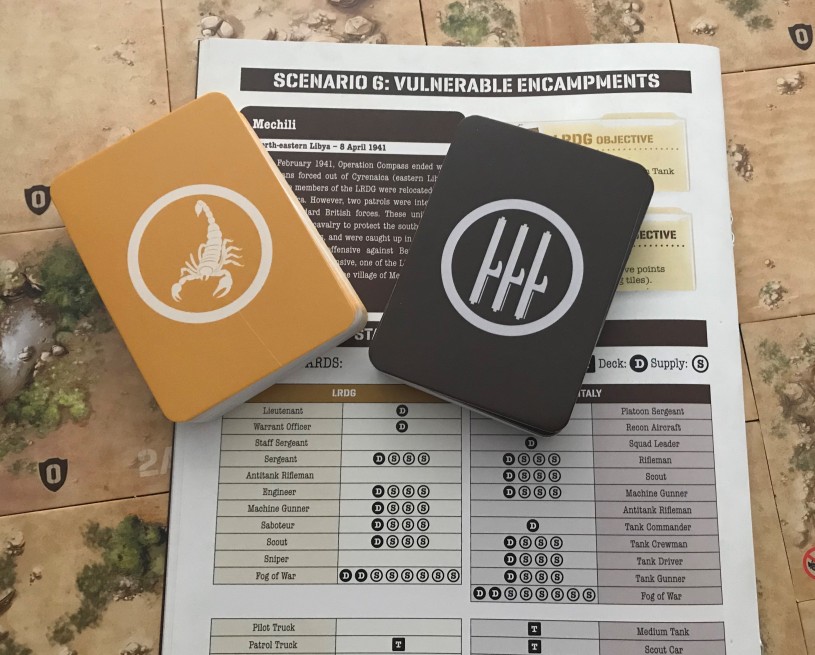
When oh when did wargamers turn into euro gamers instead of simulation gamers ?
Next move: try playing Goose chase to simulate WW2.’’
LikeLike
Since life happened to some of them, who now and then enjoy to play sthg that will note take 1 hour to set up and 8 hrs to play. (I’m still looking forward to playing some of my heaviest wargames, but with two kids and no room dedicated to my hobbies in my flat, card games will do for now).
LikeLike
The thing about wargames is that I love to play a monster wargame with 5 maps, 800 counters that takes 12-15 hours but I cannot do that every day or ever every weekend. This is what these lighter games are for. Doesn’t mean I have given up on traditional hex and counter but I play other simulations to learn different aspects. That’s just me.
LikeLike
Nice write-up.
I’ll play about any kind of game; I really appreciate different/unusual systems.
A Pet Peeve: A term that frequently seems imprecise to me is what level or scale is the game. I would propose focusing on it’s resolution units, not the size of the aggregate scenarios. In this case, I would describe it as Individual Soldier level; with scenarios of around a Squad. I know sometimes the effective echelon is composed of multiple counters, but that in itself would demand additional explanation. I only note this because I usually have to look-up the unit counters to determine what “level” the design is really set at.
LikeLike